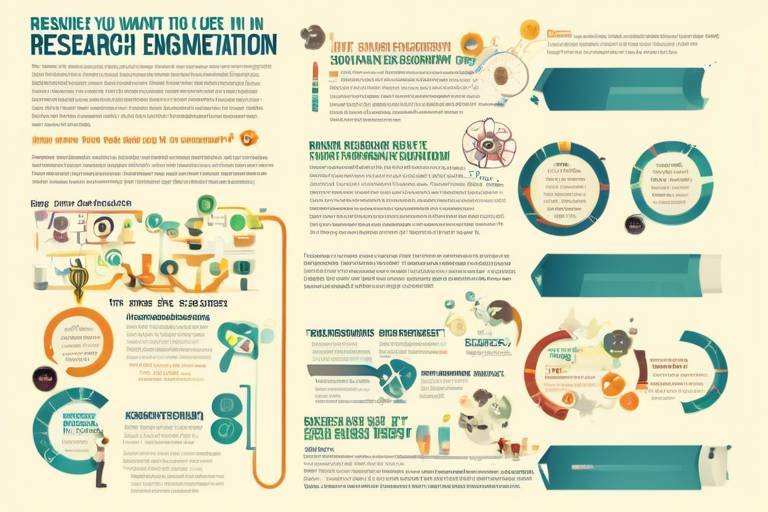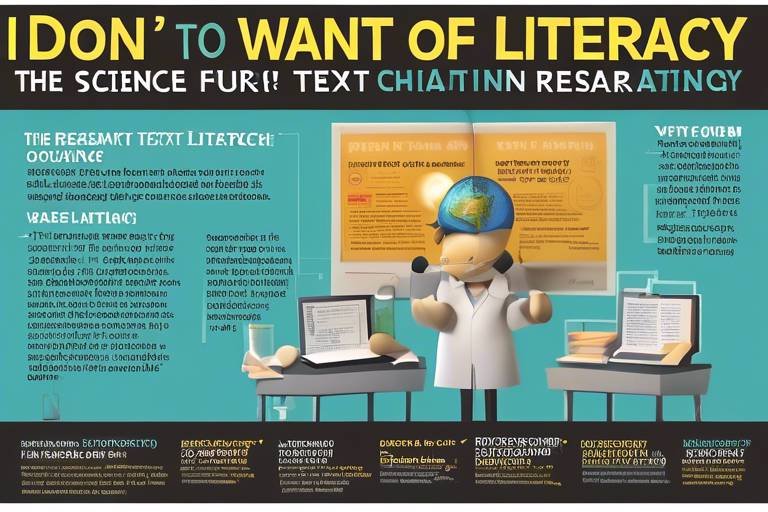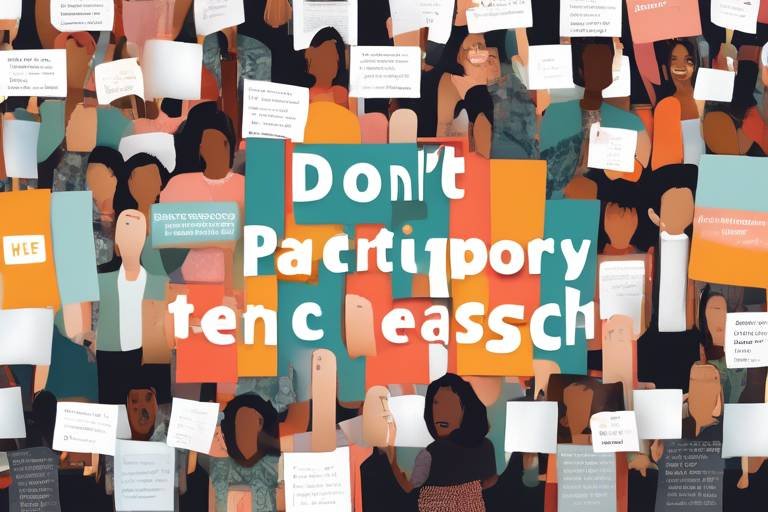The Science of Gamification in Research Engagement
In today's fast-paced world, engaging participants in research can feel like trying to catch smoke with your bare hands. With distractions around every corner, researchers are constantly on the lookout for innovative ways to capture attention and maintain interest. Enter gamification—a game-changing approach that transforms traditional research methods into dynamic, interactive experiences. By integrating game-like elements into research activities, gamification not only enhances engagement but also fosters a deeper connection between participants and the research objectives.
But what exactly is gamification? At its core, it involves the application of game design principles in non-game contexts. Think of it as sprinkling a bit of fun into the often serious business of research. This approach taps into our innate desire for competition, achievement, and recognition, making the research process more appealing. Imagine participating in a study where you earn points for completing tasks, climb a leaderboard, or unlock achievements as you progress—suddenly, what might have felt like a chore becomes an exciting challenge.
The psychological foundations of gamification are deeply rooted in behavioral science. It leverages concepts such as intrinsic and extrinsic motivation, where intrinsic motivation comes from within (like the joy of learning), while extrinsic motivation is driven by external rewards (like prizes or recognition). By understanding these motivations, researchers can design studies that not only attract participants but also encourage them to stay engaged throughout the research process.
As we delve deeper into the science of gamification in research engagement, it's essential to recognize its multifaceted benefits. From increased participant motivation to enhanced data quality and retention rates, the impact of gamification can be profound. In the following sections, we will explore these advantages in detail, highlighting how gamification can lead to more successful research outcomes.
So, are you ready to uncover the mechanics behind this exciting trend? Let’s embark on this journey to discover how gamification is revolutionizing research engagement and what it means for the future of data collection.
- What is gamification? Gamification is the integration of game design elements into non-game contexts to enhance user engagement and motivation.
- How does gamification improve research engagement? By making research activities more interactive and rewarding, gamification increases participant motivation and retention, leading to better data collection.
- Are there any risks associated with gamification in research? Yes, potential risks include over-reliance on game mechanics and the possibility of diminishing intrinsic motivation among participants.
- Can gamification be applied in all research fields? While gamification has proven effective in various fields, its application may vary based on the audience and research objectives.

Understanding Gamification
Gamification is a term that has been buzzing around in various fields, and for good reason. At its core, gamification refers to the integration of game-like elements into non-game contexts, aiming to enhance user engagement and motivation. Have you ever wondered why people are so drawn to video games? It's not just the graphics or the action; it's the intrinsic motivation that comes from leveling up, earning rewards, and completing challenges. This principle can be effectively applied to research environments, transforming mundane tasks into engaging experiences that captivate participants.
The psychological foundations of gamification are deeply rooted in human behavior. It taps into our natural desires for achievement, competition, and social interaction. When researchers incorporate gamified elements, they are essentially leveraging these psychological triggers to foster a more engaging environment. Think of it like this: if you were asked to participate in a survey, would you be more likely to respond if you knew you could earn points and compete on a leaderboard? Absolutely! This is the magic of gamification—it turns a simple task into a thrilling adventure.
In research, gamification can take various forms, including point systems, challenges, and badges. Each of these elements serves a specific purpose in enhancing participant engagement. For instance, a point system can reward participants for completing surveys, while challenges can encourage them to explore different aspects of the study. Badges, on the other hand, serve as a visual representation of achievement, allowing participants to showcase their contributions. The combination of these elements creates a more dynamic and interactive research experience.
Moreover, the relevance of gamification in research environments cannot be overstated. As researchers seek to gather quality data, they must consider how to motivate participants effectively. Gamification not only enhances engagement but also leads to improved retention rates and higher-quality data collection. By creating an environment where participants feel invested in the process, researchers can achieve more successful outcomes. In short, understanding gamification is crucial for anyone involved in research, as it opens up new avenues for participant interaction and data collection.

Benefits of Gamification in Research
Gamification has emerged as a revolutionary approach in the realm of research, breathing new life into participant engagement and data collection methods. By integrating game-like elements into research activities, researchers can tap into the innate human desire for competition, achievement, and social interaction. This not only makes the research process more enjoyable but also leads to significant improvements in various key areas. Let's delve into some of the most compelling benefits of gamification in research.
One of the standout advantages of gamification is the increased participant motivation. When participants feel like they are part of a game rather than just a study, they are more likely to engage actively. This heightened motivation can lead to higher completion rates of surveys, experiments, or other research tasks. For instance, researchers can implement point systems that reward participants for completing tasks, thereby encouraging them to stay involved throughout the research process.
Moreover, gamification can enhance the quality of data collected. When participants are more engaged and motivated, they tend to provide more thoughtful and accurate responses. This is crucial in research where data integrity is paramount. A well-designed gamified experience can lead to richer qualitative data, as participants might feel more compelled to share their genuine thoughts and feelings when they are invested in the process.
Another significant benefit is the improved retention rates. Retaining participants in longitudinal studies can be challenging, but gamification strategies can help maintain their interest over time. By incorporating elements such as progress tracking, rewards for milestones, and engaging narratives, researchers can create a sense of continuity and purpose that keeps participants coming back. This is especially important in research that spans over months or years, where maintaining participant involvement is crucial for the validity of the study.
Additionally, the social aspect of gamification should not be overlooked. Many gamified research platforms allow participants to interact with each other, fostering a sense of community. This can lead to increased participation as individuals feel more connected and accountable to one another. For example, leaderboards displaying participant rankings can spark friendly competition, motivating individuals to engage more actively. This social interaction not only enhances the research experience but also contributes to a more comprehensive understanding of the research topic through shared insights.
In summary, the benefits of gamification in research are multifaceted and can significantly enhance the overall research experience. By increasing participant motivation, improving data quality, boosting retention rates, and fostering social connections, gamification creates a win-win scenario for both researchers and participants. As we continue to explore the potential of this innovative approach, it becomes clear that gamification is not just a trend; it is a powerful tool that can transform how research is conducted and experienced.
- What is gamification in research? Gamification in research involves integrating game-like elements into research activities to enhance participant engagement and motivation.
- How does gamification improve data quality? By keeping participants engaged and motivated, gamification encourages thoughtful and accurate responses, leading to richer data.
- Can gamification be used in all types of research? While gamification is versatile, its effectiveness may vary depending on the research context and target audience.
- What are some common gamification techniques? Techniques include point systems, leaderboards, narrative elements, and rewards for participation.

Enhancing Participant Motivation
When it comes to research, one of the biggest challenges researchers face is keeping participants engaged and motivated throughout the study. After all, who wants to spend hours on a survey or experiment that feels tedious and uninspiring? This is where the magic of gamification comes into play. By incorporating game-like elements into research activities, researchers can create an environment that not only captures attention but also encourages active participation. Think about it: when was the last time you felt genuinely excited to complete a task? Probably when there was a game, a challenge, or a reward involved.
One effective strategy to enhance participant motivation is to implement game mechanics that resonate with people’s intrinsic desires. For instance, setting up a point system can turn mundane tasks into exciting challenges. Participants can earn points for completing surveys, sharing their thoughts, or even referring friends to join the study. This not only gamifies the experience but also fosters a sense of achievement. Imagine participants logging in to see their points accumulate, competing against themselves or others, and feeling that rush of accomplishment every time they hit a milestone.
Another key element is the use of leaderboards. By displaying participants' rankings based on their engagement levels, you can create a friendly competition that motivates individuals to participate more actively. However, it’s crucial to strike a balance—while some participants thrive on competition, others may feel discouraged if they perceive themselves as falling behind. Therefore, it’s essential to design leaderboards that encourage participation without alienating those who may not be as competitive.
Additionally, incorporating narrative elements into research activities can significantly enhance motivation. People are naturally drawn to stories; they evoke emotions and create connections. By framing the research within a narrative context, researchers can make participants feel like they are part of something larger than themselves. For example, presenting a health study as a quest to improve community well-being can inspire participants to engage more deeply, as they feel their contributions are meaningful.
Lastly, it’s important to remember that motivation can be fleeting. To maintain engagement over time, researchers should regularly refresh the gamification elements. This could mean introducing new challenges, updating rewards, or even changing the narrative to keep things exciting. By continuously evolving the gamified experience, researchers can ensure that participants remain motivated and invested in the study from start to finish.
In summary, enhancing participant motivation through gamification is not just about making research fun—it's about creating an engaging and rewarding experience that encourages active participation. By leveraging game mechanics, leaderboards, narrative elements, and ongoing updates, researchers can transform the way participants interact with their studies, leading to richer data collection and more successful outcomes.

Incentives and Rewards
When it comes to gamification in research, are the secret sauce that can transform participant engagement from mundane to exhilarating. Imagine you're playing your favorite video game; what keeps you glued to the screen? It's not just the storyline; it's the rewards you earn along the way! This concept translates seamlessly into research, where well-structured incentives can entice participants to dive deeper into their roles.
There are two primary types of rewards that researchers can leverage: intrinsic and extrinsic. Intrinsic rewards are those that come from within. They tap into the participant's personal satisfaction, curiosity, or sense of accomplishment. For instance, when participants feel that they are contributing to something greater, like advancing scientific knowledge or helping others, they are more likely to stay engaged. On the other hand, extrinsic rewards are tangible benefits such as gift cards, discounts, or even points that can be redeemed for prizes. Both types can be effective, but the key lies in striking a balance.
To illustrate this, let's take a look at some common incentives used in research:
| Type of Reward | Description |
|---|---|
| Gift Cards | Participants receive gift cards for completing surveys or tasks, providing immediate gratification. |
| Recognition | Public acknowledgment in newsletters or social media can motivate participants by making them feel valued. |
| Leaderboards | Displaying participant rankings can foster a sense of competition and encourage ongoing engagement. |
| Exclusive Content | Access to special research findings or educational materials can entice participants to remain active. |
However, it’s essential to tailor these incentives to the target audience. For example, younger participants might respond better to gamified elements like points and badges, while older adults may prefer more traditional rewards like cash or gift cards. The effectiveness of an incentive often hinges on its relevance to the participants' interests and motivations. Moreover, researchers should be cautious about over-relying on extrinsic rewards, as they can sometimes undermine intrinsic motivation. When participants focus solely on the reward, they may lose sight of the intrinsic value of their contributions.
Ultimately, the goal is to create a reward system that not only motivates but also enriches the research experience. By thoughtfully integrating incentives into the research design, researchers can foster a culture of engagement that encourages participants to contribute actively and meaningfully. This, in turn, leads to richer data and more impactful research outcomes. So, when designing your next study, consider how you can turn the mundane into the extraordinary with the right mix of incentives and rewards!

Feedback Mechanisms
When it comes to gamification in research, serve as the lifeblood that keeps participants engaged and motivated. Think of feedback as the fuel that powers a car; without it, the journey can come to a grinding halt. In research contexts, timely and constructive feedback not only enhances the participant experience but also encourages continuous involvement in the study. Imagine being in a game where you never receive any updates on your progress or achievements. Frustrating, right? The same principle applies to research.
Effective feedback can take many forms, such as instant notifications, progress updates, or even personalized messages that acknowledge a participant's efforts. For example, if a participant completes a survey, receiving immediate feedback on their contribution can make them feel valued and appreciated. This sense of recognition can significantly enhance their commitment to the research project. Additionally, when participants see how their input contributes to the larger goals of the study, it creates a sense of purpose that can motivate them to stay involved.
Moreover, feedback mechanisms can be categorized into two main types: quantitative and qualitative. Quantitative feedback includes scores, rankings, or metrics that provide participants with a clear picture of their performance. On the other hand, qualitative feedback involves personalized messages or comments that offer insights into their contributions. Both types are essential, as they cater to different motivational needs. For instance, a leaderboard might excite competitive participants, while personalized feedback can resonate more with those who seek affirmation and connection.
To illustrate the effectiveness of feedback mechanisms, consider the following table that outlines various feedback methods and their potential impact on participant engagement:
| Feedback Method | Type | Impact on Engagement |
|---|---|---|
| Instant Notifications | Quantitative | Encourages immediate participation and keeps motivation high |
| Personalized Messages | Qualitative | Fosters a sense of connection and belonging |
| Progress Bars | Quantitative | Visual representation of progress can drive continued engagement |
| Peer Comparisons | Quantitative | Stimulates healthy competition and enhances motivation |
In conclusion, feedback mechanisms are not just an add-on; they are a critical component of gamification in research that can significantly influence participant motivation and engagement. By implementing effective feedback strategies, researchers can create a more dynamic and interactive environment that encourages participants to remain actively involved in the study. After all, who doesn’t love a little recognition for their hard work?
- What is the role of feedback in gamification?
Feedback is essential as it informs participants about their progress and enhances their engagement by making them feel valued. - How can feedback be delivered effectively?
Feedback can be delivered through instant notifications, personalized messages, progress bars, and peer comparisons. - Are there different types of feedback?
Yes, feedback can be categorized as quantitative (like scores and rankings) or qualitative (like personalized comments).

Gamification Techniques in Research
When we talk about gamification techniques in research, we're diving into a treasure trove of methods that can transform a mundane study into an engaging experience. Imagine turning a tedious survey into an exciting quest where participants feel like heroes on a mission! This is precisely what gamification achieves by integrating game-like elements into research activities. The key techniques that researchers can utilize include point systems, leaderboards, and narrative elements, each playing a unique role in enhancing participant engagement.
First off, point systems are one of the most common gamification techniques employed in research. They work by rewarding participants with points for completing tasks, answering questions, or engaging with content. This not only adds a competitive edge but also creates a sense of accomplishment. For instance, in a health study, participants could earn points for logging their daily exercise or maintaining a food diary. The accumulation of points can lead to tangible rewards, further incentivizing participants to stay engaged.
Next, we have leaderboards. These are visual displays that rank participants based on their performance or points earned. Leaderboards tap into our natural competitive instincts and can motivate participants to strive for higher rankings. However, it's essential to balance this competition; if a leaderboard is too intimidating, it might discourage lower-ranking participants. Therefore, researchers often implement multiple leaderboards based on different criteria, allowing everyone a chance to shine in various categories, such as "Most Improved" or "Best Team Player."
Another fascinating technique is the incorporation of narrative elements. By embedding a story into the research process, participants can feel more connected to the study. For example, a study on environmental awareness could frame tasks as missions in a quest to save the planet. This narrative approach not only keeps participants engaged but also helps them understand the significance of their contributions. By linking tasks to a larger story, researchers can foster a sense of purpose that resonates with participants.
Moreover, gamification can be enhanced through social interaction. Encouraging participants to collaborate or compete with friends can significantly boost engagement. For instance, creating teams for a research study can foster camaraderie and accountability. Participants may feel more inclined to engage if they know their friends are also involved, creating a supportive community around the research project.
Finally, it's worth mentioning the importance of customization in gamification techniques. Allowing participants to choose their avatars or select different paths in a study can lead to a more personalized experience. This sense of ownership can enhance motivation and commitment, making participants feel like active contributors rather than passive subjects.
In summary, the implementation of gamification techniques in research can significantly enhance participant engagement and data quality. By leveraging point systems, leaderboards, narrative elements, social interactions, and customization, researchers can create a dynamic and interactive environment that not only motivates participants but also yields richer data. The next step is to explore real-world applications of these techniques, showcasing their effectiveness across various research fields.
- What is gamification? Gamification is the integration of game-like elements into non-game contexts to enhance user engagement.
- How does gamification improve research participation? By making research activities more engaging and rewarding, gamification boosts motivation and encourages continuous involvement.
- What are some common gamification techniques used in research? Common techniques include point systems, leaderboards, narrative elements, social interaction, and customization.
- Can gamification be applied to all types of research? While gamification can enhance many research types, its effectiveness may vary depending on the target audience and research goals.

Case Studies of Gamification in Research
Gamification has proven to be a game-changer (pun intended) in various research fields, significantly enhancing participant engagement and improving data collection outcomes. Let’s dive into some compelling case studies that illustrate the transformative power of gamification in research settings. These examples not only highlight the effectiveness of gamified approaches but also provide insights into how they can be implemented across diverse areas.
One notable case study comes from the realm of health research. Researchers at a prominent university developed a mobile application designed to encourage physical activity among participants. By incorporating game mechanics like challenges, badges, and leaderboards, the app turned mundane exercise routines into exciting quests. Participants could set personal goals and compete with friends, which significantly increased their motivation. As a result, the study recorded a remarkable 30% increase in physical activity levels among participants compared to traditional methods.
In another fascinating example from educational research, a team of educators sought to enhance student engagement in a long-term study about learning outcomes. They introduced a gamified platform where students could earn points for completing assignments, participating in discussions, and collaborating with peers. The introduction of narrative elements, such as a storyline where students progressed through different levels based on their achievements, made learning feel like an adventure. This approach led to a 25% improvement in student retention rates and a noticeable increase in overall academic performance.
To further illustrate the impact of gamification, let's take a look at the following table summarizing key findings from these case studies:
| Case Study | Field | Gamification Elements Used | Outcome |
|---|---|---|---|
| Mobile App for Physical Activity | Health Research | Challenges, Badges, Leaderboards | 30% increase in physical activity |
| Gamified Learning Platform | Educational Research | Points, Storyline, Levels | 25% improvement in retention and performance |
These case studies exemplify how gamification can breathe new life into research methodologies. By engaging participants through fun and interactive elements, researchers can not only enhance the quality of data collected but also create a more enjoyable experience for participants. However, it’s essential to tailor gamification strategies to the specific context and audience to maximize effectiveness.
As we explore further, it’s crucial to acknowledge that while the benefits of gamification are significant, understanding the potential challenges and limitations is equally important. This ensures that gamified approaches are implemented thoughtfully, maintaining a balance between motivation and intrinsic engagement.

Health Research Applications
In the realm of health research, gamification has emerged as a powerful tool that not only captivates participants but also enhances the quality of data collected. Imagine a scenario where participants are not just passive subjects but active players in their health journey. This transformation has been made possible through the integration of game-like elements into research methodologies. For instance, studies have shown that when participants engage in health-related tasks framed as games, their motivation significantly increases. This is particularly evident in areas such as chronic disease management, where adherence to treatment regimens can be challenging.
One compelling example comes from a study that utilized a mobile application designed for patients with diabetes. The app incorporated points, badges, and leaderboards to encourage users to monitor their blood sugar levels regularly. As participants tracked their progress, they not only received immediate feedback but also saw their standing compared to others, fostering a sense of community and competition. This gamified approach led to a remarkable increase in adherence rates, with participants reporting a greater sense of accountability and motivation to manage their health.
Moreover, gamification can also be beneficial in clinical trials. Traditional clinical trials often struggle with participant retention, leading to incomplete data and skewed results. However, by incorporating gamified elements, researchers can create a more engaging environment. For example, participants might earn rewards for completing surveys or attending appointments, making the process feel less like a chore and more like an engaging experience. This not only improves retention rates but also enhances the quality of the data collected, as participants are more likely to provide accurate and timely information.
To illustrate the impact of gamification in health research, consider the following table that summarizes some successful applications:
| Study | Gamification Elements | Results |
|---|---|---|
| Diabetes Management App | Points, badges, leaderboards | Increased adherence by 30% |
| Clinical Trial for Depression | Reward points for survey completion | Improved retention by 40% |
| Weight Loss Challenge | Team competitions, weekly challenges | Participants lost an average of 10% body weight |
These examples highlight how gamification not only enhances participant engagement but also leads to better health outcomes. By transforming the research experience into an interactive and rewarding journey, researchers can tap into the innate human desire for achievement and community. As the field of health research continues to evolve, the integration of gamification will likely play a critical role in shaping future studies and improving patient outcomes.
- What is gamification in health research? Gamification in health research refers to the use of game-like elements to enhance participant engagement and motivation in health-related studies.
- How does gamification improve participant motivation? By incorporating rewards, feedback, and competition, gamification makes the research process more engaging, encouraging participants to take an active role in their health.
- Are there any challenges associated with gamification? Yes, while gamification has many benefits, it can lead to over-reliance on game mechanics and may diminish intrinsic motivation if not implemented carefully.

Educational Research Applications
Gamification has revolutionized educational research, transforming traditional methodologies into dynamic, engaging experiences that captivate students and educators alike. By integrating game-like elements into research studies, educators can foster a more interactive learning environment that not only encourages participation but also enhances retention of knowledge. Imagine a classroom where students are not just passive recipients of information but active players in their educational journey. This shift in perspective can lead to profound changes in how research is conducted and how results are interpreted.
One of the most striking examples of gamification in educational research is the use of interactive simulations. These simulations allow students to explore complex concepts in a risk-free environment. For instance, a study involving a virtual biology lab enabled students to conduct experiments that would be impossible or unsafe in a traditional classroom setting. By manipulating variables and observing outcomes in real-time, students not only grasped the material better but also developed critical thinking skills. This hands-on approach can be likened to a video game where players learn through trial and error, ultimately leading to a deeper understanding of the subject matter.
Moreover, gamified elements such as leaderboards, badges, and achievement levels have been successfully implemented to motivate students. Research has shown that when students see their progress visually represented, it can significantly boost their motivation to engage with the material. For example, a recent educational study found that students who participated in a gamified curriculum scored 20% higher on assessments than those who followed a traditional learning path. This statistic underscores the potential of gamification to not only make learning fun but also to enhance educational outcomes.
In addition to improving motivation and engagement, gamification also encourages collaboration among students. Many educational research projects now incorporate team-based challenges, where students work together to solve problems or complete tasks. This collaborative approach mirrors the dynamics of multiplayer games, fostering a sense of community and shared purpose. Students learn from one another, share insights, and develop important social skills that are crucial for their future endeavors. The ability to collaborate effectively is akin to being part of a team in a sports game, where every player’s contribution is vital to achieving victory.
However, it's essential to recognize that while gamification can significantly enhance educational research, it is not without its challenges. Some educators express concerns about the potential for students to become overly focused on rewards at the expense of genuine learning. Striking the right balance between fun and educational value is crucial. To mitigate this risk, researchers and educators must carefully design gamified elements that align with learning objectives, ensuring that the primary focus remains on knowledge acquisition rather than merely accumulating points or badges.
In conclusion, the applications of gamification in educational research are vast and varied. From interactive simulations that allow for experiential learning to collaborative challenges that foster teamwork, the potential for enhanced engagement and improved outcomes is clear. As we continue to explore the intersection of gaming and education, it’s vital to remain mindful of the challenges while embracing the opportunities that gamification presents. By doing so, we can create a more engaging and effective educational landscape for future generations.
- What is gamification in educational research?
Gamification in educational research involves incorporating game-like elements into educational methodologies to enhance student engagement and motivation. - How does gamification improve learning outcomes?
Gamification can improve learning outcomes by making education more interactive and enjoyable, leading to higher retention rates and better understanding of the material. - Are there any challenges associated with gamification?
Yes, challenges include the risk of students focusing too much on rewards rather than learning, requiring careful design to ensure educational value is maintained. - Can gamification be applied to all subjects?
While gamification can be applied to many subjects, the effectiveness may vary depending on the content and the age group of the students.

Challenges and Limitations of Gamification
While gamification holds tremendous potential for enhancing research engagement, it's not without its challenges and limitations. One of the primary concerns is the risk of over-reliance on game mechanics. When researchers focus too heavily on the gaming elements, they may inadvertently dilute the core objectives of their studies. This can lead to a situation where the fun of the game overshadows the actual research goals, causing participants to lose sight of the important data they are supposed to contribute.
Another significant challenge is the potential for diminishing intrinsic motivation. Gamification often employs extrinsic rewards, such as points or prizes, to encourage participation. While these can be effective in the short term, they might undermine participants' intrinsic motivation over time. If individuals become too accustomed to receiving rewards for their engagement, they may struggle to find personal value in the research itself, leading to decreased long-term participation.
Moreover, the design of gamified elements must be carefully considered. If the game mechanics are not well-aligned with the research objectives, participants may become confused or disengaged. For instance, a poorly designed point system could lead to frustration rather than motivation, ultimately harming the research outcomes. It's crucial for researchers to strike a balance between engaging game features and the scientific rigor required for valid data collection.
Additionally, not all participants may respond positively to gamification. Individual differences in personality, preferences, and motivations can significantly affect how people engage with gamified elements. For some, the competitive nature of leaderboards may be a motivating factor, while for others, it could induce stress and anxiety. Therefore, researchers must be aware of the diverse backgrounds of their participants and tailor their gamification strategies accordingly.
Lastly, there is the challenge of ensuring data integrity. While gamification can enhance engagement, it can also lead to data that is less reliable if participants are more focused on playing the game than providing accurate responses. Researchers need to implement robust measures to verify the authenticity of the data collected through gamified methods, ensuring that the benefits of engagement do not come at the cost of quality.
In summary, while gamification can be a powerful tool in research engagement, it comes with its own set of challenges. Researchers must navigate these carefully, balancing the fun and engaging aspects of gamification with the serious objectives of their studies. By doing so, they can harness the full potential of gamification while minimizing its limitations.
- What is gamification? Gamification is the application of game-like elements in non-game contexts to enhance user engagement and motivation.
- How can gamification be applied in research? Researchers can use gamification techniques such as point systems, leaderboards, and rewards to encourage participation and improve data collection.
- What are the potential downsides of gamification? Challenges include over-reliance on game mechanics, diminishing intrinsic motivation, poorly designed game elements, and variations in participant responses.
- Can gamification improve data quality? Yes, when implemented correctly, gamification can enhance participant engagement, leading to higher quality data collection.
Frequently Asked Questions
- What is gamification in research?
Gamification in research refers to the integration of game-like elements into research activities to boost engagement and participation. This approach uses concepts such as points, rewards, and challenges to motivate participants and enhance their overall experience.
- How does gamification increase participant motivation?
Gamification increases participant motivation by making the research process more interactive and enjoyable. By incorporating elements like leaderboards, achievement badges, and instant feedback, participants are more likely to stay engaged and committed to the research activities.
- What types of rewards are effective in gamification?
Both intrinsic and extrinsic rewards can be effective in gamification. Intrinsic rewards include personal satisfaction and a sense of achievement, while extrinsic rewards might involve tangible incentives like gift cards or recognition. The key is to find a balance that resonates with participants.
- Can gamification improve data quality?
Yes! Gamification can significantly enhance data quality by encouraging participants to be more attentive and engaged during the research process. When participants are motivated and actively involved, they are likely to provide more accurate and thoughtful responses.
- What are some common gamification techniques used in research?
Common gamification techniques in research include point systems, where participants earn points for completing tasks; leaderboards that display top performers; and narrative elements that create a story around the research, making it more relatable and engaging for participants.
- Are there any challenges associated with gamification in research?
Yes, there are challenges. One major concern is the potential over-reliance on game mechanics, which might lead to a decrease in intrinsic motivation. Additionally, not all participants may respond positively to gamified elements, so it's essential to tailor the approach to the audience.
- How has gamification been applied in health research?
In health research, gamification has been used to encourage participants to adopt healthier behaviors and adhere to treatment plans. For example, studies have shown that gamified interventions can lead to increased physical activity and better management of chronic conditions.
- What impact does gamification have on educational research?
Gamification in educational research has transformed learning experiences by fostering deeper engagement among students. By incorporating game elements, researchers have observed improved motivation, participation, and retention of information in educational settings.



















